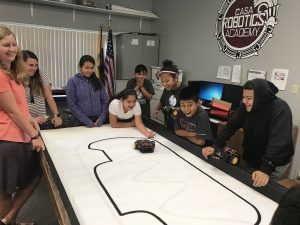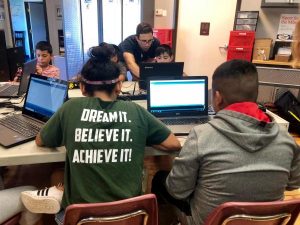
This hands-on learning experience is part of the Institute for Modeling Plasma, Atmospheres, and Cosmic Dust (IMPACT) Junior Aerospace Engineering Camp, a summer program offered by LASP’s Office of Communications and Outreach (OCO).
Now in its fifth year, the NASA-supported program is held at Casa de la Esperanza, a housing community and learning center in Longmont, Colorado, designed to support agricultural migrant workers and their families. The IMPACT camp is one of several educational services that the facility offers to residents.
Over the course of the program, students started with basic robotics kits and progressed to more advanced technology. At the same time, they went from dragging and dropping pre-written code to writing their own code and building their own robots, learning how to assemble and solder the tiny circuits and components.
LASP education and public outreach specialist Bryan Costanza says this camp introduces students to Science, Technology, Engineering, and Math (STEM) careers.
“The intent in general is to bring these education opportunities to underserved communities and bring resources to them that would not be available otherwise,” Costanza said.

Burning rubber
Past curricula focused on designing rockets, but this year’s projects focused on robotics. The students created their own functioning robots and wrote code that allowed them to complete specific functions, like going around the two-dimensional racecourse.
The rolling robots used a sensor to scan for a black line drawn on white paper and followed that line as they raced. The students also coded in real-time to control how fast or slow their robots went.
Tom Mason, LASP’s OCO manager, believes this unique program will put students at an advantage in the STEM fields by teaching them valuable technology skills at a young age.
“We’re connecting NASA, the university, and the work that we do to a community program that has real and tangible benefits for these students,” Mason said.
Costanza said the students learned teamwork as they worked in groups. If a robot wasn’t functioning properly, for example, they had to collaborate to modify their coding.
Mason likened the skills to those used at LASP, where researchers communicate with robots in space through coding and programming similar to what the students learned in the camp.
“When we send commands to the spacecraft, we’re doing the same thing that these students are doing on their computers,” Mason said.
Thinking on their feet
The IMPACT camp also gave the students a crash course in problem solving. The students went through a trial-and-error process when computer coding the robot to follow the line correctly.
“They must identify the problem, identify the solutions, and then test out those solutions to see if they work,” Mason said. “It’s all part of the engineering process.”
Camp participant Nelly Jimenez wants to be a doctor when she grows up. The 11-year-old thinks the camp will help her achieve that goal by familiarizing her with complex technology.
“I like that I get to learn new activities,” Jimenez said. “I had never used a robot before.”
Although the program is in its final year of funding, it will continue as an after-school program this fall. That way, the students will have the opportunity to improve their computer coding skills and keep building functioning robots from unassembled kits.
Costanza and Mason plan to continue working with the students and to continue to build their love of working with robots and STEM fields in general.
“The goal is to set them free into the world of robotics,” Costanza said.
This story, written by Molly Phannenstiel, originally appeared in CU Boulder Today.
[addthis]



